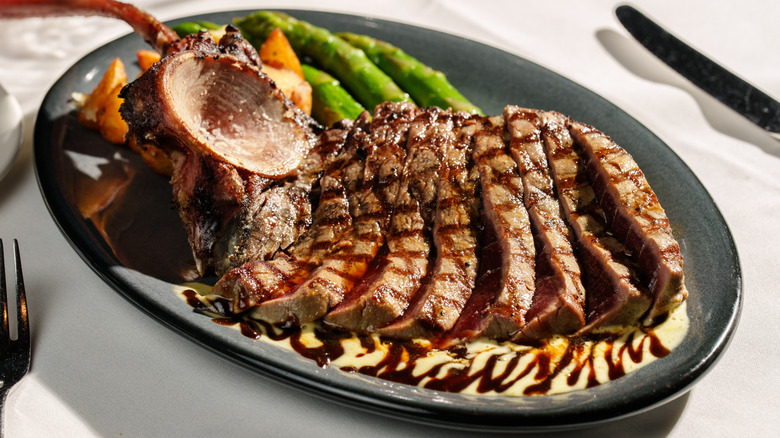How Dry-Aged Fish Mimics The Meaty Flavor Of Steak
We may receive a commission on purchases made from links.
For centuries, Japanese chefs have wet aged fish, while Icelandic chefs have dry aged fermented shark meat known as hákarl. However, the technique of dry aging fish has only become a worldwide trend since the release of Aussie Chef Josh Niland's "The Whole Fish Cookbook: New Ways to Cook, Eat and Think" in 2019. One reason for dry-aged fish's popularity is that it tastes a lot like steak. It can be difficult to get your head around fish tasting like beef because their aromas and textures are totally different, but science reigns supreme here.
The strong smell that fish develops after a few days comes from leftover blood and slime. Since dry aging evaporates moisture, those residuals drain away, leaving fish clean and odorless. Also, the protein enzymes in the flesh break down over time, making the texture more tender and buttery. While drying, a natural umami flavor is released from the broken-down proteins (like in Japanese kombu). The flavor comes from amino acid chains in fish, specifically glutamate. The amount of this enzyme increases throughout the aging process and intensifies the fish's flavor.
Making and serving dry-aged fish at home
When it comes to dry aging fish yourself, you might want to visit a seafood market instead of than buying fish at the supermarket. Getting a high-quality product is more important than whether it's fresh or frozen, though. If you get a whole fish, you'll need to scale and gut it and then wash the flesh with saltwater. Next, dry the filets with paper towels, place the fish on a grate with a tray underneath to catch dripping fluids, and stick it in a refrigerator at about 35 degrees Fahrenheit to dry out for two or three days. This air-drying technique is a foolproof way to achieve restaurant-quality meat.
At this point, you can treat dry-aged fish like it's fresh: Use it for sushi or in raw dishes like crudo or poke, sear it in a pan with olive oil, or grill it over a flame. Like with fresh fish, be careful that you don't overcook it. Also, since dry-aged fish has such a concentrated flavor, it's best to keep the additional ingredients to a minimum. The same is true when choosing your side dishes. You don't want to outshine the fish, so stick to light-flavored foods, such as roasted vegetables (asparagus, green beans, carrots), grains, and salads. And, you can't go wrong with a bread side, such as crunchy garlic bread or buttery dinner rolls.

